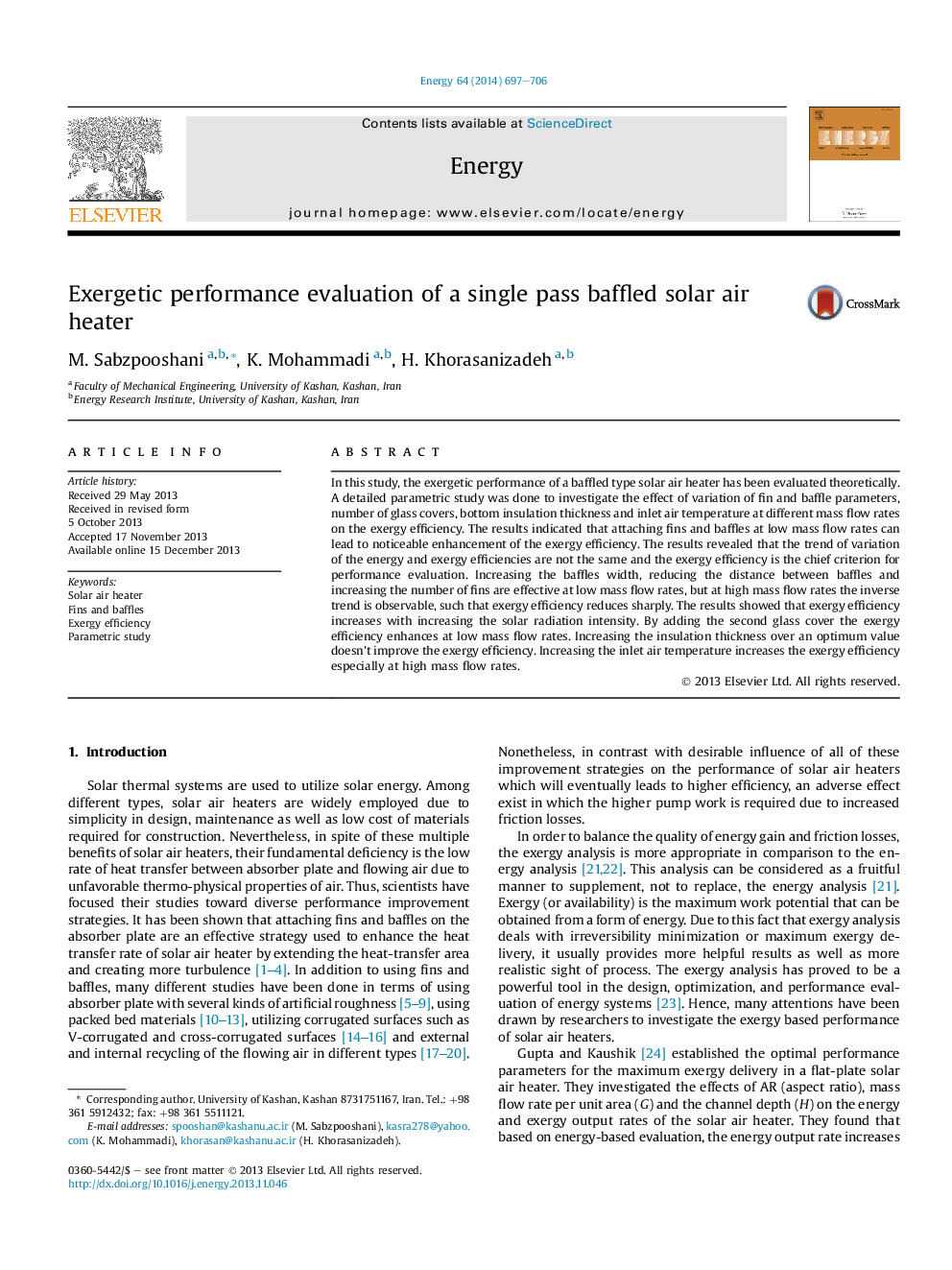| کد مقاله | کد نشریه | سال انتشار | مقاله انگلیسی | نسخه تمام متن |
|---|---|---|---|---|
| 8078817 | 1521482 | 2014 | 10 صفحه PDF | دانلود رایگان |
عنوان انگلیسی مقاله ISI
Exergetic performance evaluation of a single pass baffled solar air heater
ترجمه فارسی عنوان
ارزیابی عملکرد شدید یک بخار خورشیدی خنک کننده تک فاز
دانلود مقاله + سفارش ترجمه
دانلود مقاله ISI انگلیسی
رایگان برای ایرانیان
کلمات کلیدی
بخاری هوا خورشیدی، فین ها و سوپاپ ها، راندمان اگزرژی، مطالعه پارامتری،
ترجمه چکیده
در این مطالعه، عملکرد بی نظیر یک نوع بخار خورشیدی خورشیدی با تأثیر نامطلوب به صورت نظری مورد ارزیابی قرار گرفته است. برای بررسی اثر تغییرات پارامترهای فیبر و بافر، تعداد پوشش شیشه ای، ضخامت عایق های پایه و دمای هوای ورودی در جریان های جرمی متفاوت در بهره وری اگزرژی، یک مطالعه دقیق پارامتری انجام شد. نتایج نشان می دهد که باله ها و دیواره های اتصال با سرعت جریان جرم کم می توانند منجر به افزایش قابل ملاحظه کارایی اگزرژی شوند. نتایج نشان داد که روند تغییرات انرژی و بازده های اگزرژی یکسان نیست و بهره وری اگزرژی معیار اصلی ارزیابی عملکرد است. افزایش عرض طرفداران، کاهش فاصله بین بازتاب ها و افزایش تعداد باله ها در جریان جرم کم جرم تاثیر می گذارد، اما در جریان جریان جرم بالا روند معکوس قابل مشاهده است، به طوری که کارایی اگزرژی به شدت کاهش می یابد. نتایج نشان داد که بهره وری اگزرژی با افزایش شدت تابش خورشید افزایش می یابد. با اضافه کردن پوشش شیشه دوم، بازدهی اگزرژی در جریان جریان کم جرم افزایش می یابد. افزایش ضخامت عایق بر روی یک مقدار بهینه، کارایی اگزرژی را بهبود نمی بخشد. افزایش دمای هوای ورودی، کارایی اگزرژی را به ویژه در جریان جریان جرمی بالا افزایش می دهد.
موضوعات مرتبط
مهندسی و علوم پایه
مهندسی انرژی
انرژی (عمومی)
چکیده انگلیسی
In this study, the exergetic performance of a baffled type solar air heater has been evaluated theoretically. A detailed parametric study was done to investigate the effect of variation of fin and baffle parameters, number of glass covers, bottom insulation thickness and inlet air temperature at different mass flow rates on the exergy efficiency. The results indicated that attaching fins and baffles at low mass flow rates can lead to noticeable enhancement of the exergy efficiency. The results revealed that the trend of variation of the energy and exergy efficiencies are not the same and the exergy efficiency is the chief criterion for performance evaluation. Increasing the baffles width, reducing the distance between baffles and increasing the number of fins are effective at low mass flow rates, but at high mass flow rates the inverse trend is observable, such that exergy efficiency reduces sharply. The results showed that exergy efficiency increases with increasing the solar radiation intensity. By adding the second glass cover the exergy efficiency enhances at low mass flow rates. Increasing the insulation thickness over an optimum value doesn't improve the exergy efficiency. Increasing the inlet air temperature increases the exergy efficiency especially at high mass flow rates.
ناشر
Database: Elsevier - ScienceDirect (ساینس دایرکت)
Journal: Energy - Volume 64, 1 January 2014, Pages 697-706
Journal: Energy - Volume 64, 1 January 2014, Pages 697-706
نویسندگان
M. Sabzpooshani, K. Mohammadi, H. Khorasanizadeh,
